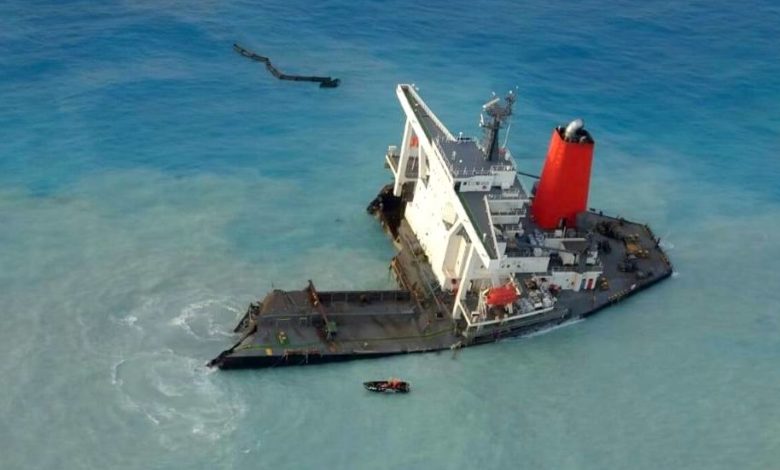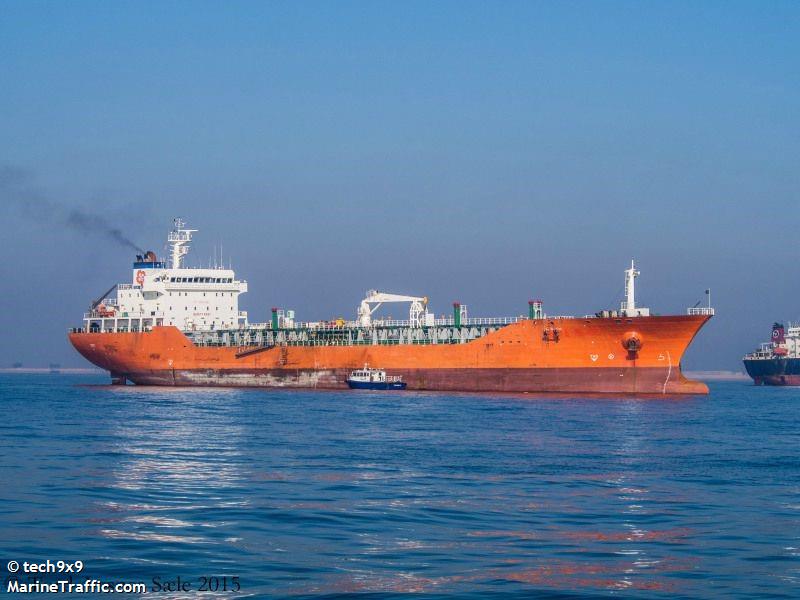Wakashio stern to be removed from reef in complex process taking months

Nagashiki Shipping, the Japanese owner of the Wakashio newcastlemax that ran aground on coral reefs off Mauritius in July, has appointed a Chinese salvor to move the stern of the ship.
Lianyungang Dali Underwater Engineering is currently transporting materials and preparing equipment in order to commence work. The processing work is scheduled to start in late December, and the final removal is expected to be completed next spring, Nagashiki stated in an update. The front three-quarters of the ship, which was on charter to Mitsui OSK Lines (MOL), was towed out to sea and scuttled in August.
Salvage sources in Mauritius tell Splash that the way the stern is so firmly lodged onto the reef will mean further ecological damage will be inevitable in removing it.
Of the approximately 1,000 tons of bunker oil spilled from the ship, the recovery of the oil floating on the sea has been completed, Nagashiki reported in today’s update. Work is ongoing to remove the oil that has washed ashore along about 30 km of the coast. Nagashiki said it expects this clean-up to be completed in January next year.
“The cause of the incident is currently being investigated by the Mauritius authorities and the investigation with the Captain is continuing,” a spokesperson for the shipowner said.

 newcastlemax that
newcastlemax that
The saddest part about the Wakashio saga is that it was all so avoidable. Accidents happen – and we have yet to hear exactly how this one did happen – but vital hours and days were lost immediately after the grounding that could have prevented the ship becoming jammed stern-on to the reef and spilling bunkers into the lagoon.
Lessons will have to be learned, not just in Mauritius (where Wakashio has become an intensely political matter) but also elsewhere about the planning, equipment, personnel, training, co-ordination, transparency, public communications and environmental response needed after a major incident, especially one close to or likely to affect environmentally sensitive waters and coasts.
Nagashiki and the crew clearly have serious questions to answer, but so too do original salvor SMIT and, above all, the Mauritian government, whose response and reaction have been lamentably unprofessional, defensive and secretive. Some of the online media coverage – from one source in particular – has been marked by groundless speculation, ignorance and irresponsible conspiracy-mongering.
Wakashio will go down in the annals of maritime casualties as an example of how not to do it. Let’s hope that Lianyungang Dali Underwater Engineering can salvage some good news from this story. I wish them, and Mauritius – particularly the fishermen and other inhabitants of the east coast – well.
Unfortunately Mauritius had no vessel powerful enough to respond immediately and pull the ship off. The spilled oil was largely inaccessible from the shoreline. I doubt a tug or two powerful enough to pull the ship off could have arrived before the hull started to split due to wave action on the exposed part levering against the secured stern. Mauritius has a lot to answer for for it’s lack of preparedness and readiness for such a catastrophe, a catastrophe which was easily predicted. Since this disaster l have not heard of Mauritius even planning to look at this problem.
Things you should know. it appears the Master(Captain) is Indian, aged 58. He and the Chief Officer(probably the Officer on Watch at the time), a Sri Lankan, were taken into custody. By all accounts there was a birthday party being held at the time. The ship was steering close to Mauritius in order to be within range of a 4G cellphone signal so that they could talk to their families at home. Apparently this is a widespread practice in modern shipping, and may account for a number of similar accidents. The Mauritius authorities detected the ship on a course that would put it aground and repeatedly called the ship, probably on Channel 16 VHF radio, to warn it off. They received no reply. Absent mechanical problems, which have never been reported, the ship ran aground because there was nobody on the bridge keeping a proper lookout by ear(radio) or sight, since the ship ran aground in broad daylight. Although making a landfall, the Master was not on the bridge either. Therefore the bridge was effectively unmanned, on autopilot, while the crew took part in the birthday party, the high point of which was saying hello to family in the Philippines or India by 4G cellphone connecting via Mauritius. So…….the Master was delinquent, and should be jailed for the environmental damage that was inflicted upon the coastline. Being 58, it is unlikely he will sail again. On a lesser charge, because he was subordinate to the Master, the Chief Officer should be censured and his licence withdrawn, with less jail time. Now, the Mauritius government must look at this practice of ships passing dangerously close to it’s shore to obtain a 4G signal. One strategy may be to increase 4G power so that it is receivable, say, 10 miles offshore. This should then be promulgated throughout the world shipping industry. This, and declaring a 10 mile exclusion zone, setting up radar coverage out 24 miles or so, and having a helicopter on stand by to ward off ships that penetrate the 10 Mile exclusion zone. If it’s affordable small, high-speed military craft should be patrolling and also respond to penetration of the exclusion zone by the radar station(s). That is the only way l can see Mauritius not being a victim of this practice in the future, with the same result. The pollution can never be removed completely. Check the enduring effect of the Exxon Valdez disaster upon Alaska, to this day. Had she been a tanker the damage would have been cataclysmic.
> “The Mauritius authorities detected the ship on a course that would put it aground and repeatedly called the ship, probably on Channel 16 VHF radio, to warn it off. They received no reply.”
That is the version put out by the National Coast Guard (NCG) and the CCID. Oddly, although those attempted calls were logged at the Pointe du Diable coastguard post, the VDR did not record any such calls being received on the bridge.
We now have an (admittedly uncorroborated) report from opposition leader Arvin Boolell, quoting an unnamed whistleblower, that only one, apparently inexperienced, NCG officer was at the CG post at the time and he was not fully up to speed with the operation of the radar and radio. He alleged that the Pointe du Diable logbook has been tampered with.
Curiously, while Pointe du Diable couldn’t get through to Wakashio, as soon as the ship came in range of Blue Bay CG post, communication was successful. But by then the ship was aground.
> “the ship ran aground because there was nobody on the bridge keeping a proper lookout by ear(radio) or sight, since the ship ran aground in broad daylight”
On the east coast of Mauritius 19.25 is, at best, dusk rather than “broad daylight”! Nevertheless, as the ship approached Mauritius two hours earlier the coast should have been visible – there are distinctive features to look out for such as Lion Mountain and the remains of the lighthouse on Ile aux Fouquets. Given that the plan was to keep 5 miles off the coast, a glance from the starboard bridge wing would have shown that they were getting too close for comfort.
Panama’s preliminary report issued on 7 September stated that the captain, F/O and chief engineer were all present on the bridge (although this contradicts evidence from crew members that the captain was in a crew member’s cabin). Panama stated: “…it seems that the wrong chart was being used and with the wrong scale, which made it impossible to properly verify the approach to the coast and shallower waters”. But if you just look out of the window…
IF these two, admittedly uncertain, pieces of ‘evidence’ are put together, you have the perfect conditions for an otherwise inexplicable accident: distraction and poor use of navigation equipment on board, and sloppy practices and poor use of comms equipment on shore.
Captain Nandeshwar will doubtless be required to shoulder much of the blame for this. But the finger of blame should also be pointing to the NCG, which signally failed in its duty not just to keep Mauritius safe but also to keep the ship and its crew safe. When a massive ship is on a direct course for Mahebourg bus station, simply sitting in a cosy little guard post and making a few calls and wondering why no one is answering is a gross dereliction of duty. It should have been treated as a major emergency warranting launching fast patrol boats and/or a helicopter to alert the vessel, using flares to attract attention if necessary. Imagine if it had been a fully laden VLCC or an LNG carrier or a cruise ship…
Mauritius has been painting itself as a poor, vulnerable little island. It isn’t. It’s a middle income country, among the wealthiest in Africa and the Indian Ocean region, and is very well equipped (thanks to the generosity of India and the EU). Unfortunately, it’s hampered by arrogant and semi-delusional political leadership, past and present. Mauritius should, in theory, be perfectly capable of defending itself against errant ships. That it wasn’t was down to equipment failures due to lack of maintenance, poor communications, the stuffing of senior operational positions with third-rate political appointees, and a failure to instil professionalism in people in safety/security-critical maritime posts.
The captain has been held since August WITHOUT CHARGE, his applications for bail repeatedly refused. The ‘preliminary’ charge is an unconstitutional Mauritian fiction; a preliminary charge has no validity in Mauritian law and it’s an abuse of human rights. s5(1) & (2) of the Piracy & Maritime Violence Act 2011 is wholly inappropriate for anything other than a DELIBERATE attack on shipping or maritime facilities; no prosecution in a well-run court could ever succeed. Continuing to keep Nandeshwar and Subodha in custody while other contributors to this mess – arguably including the PM, his adviser Ken Arian and the NCG commander – haven’t even been questioned is a disgrace.
The seafarers’ incarceration without charge and without trial is a ruse to secure extra compensation from the Japanese. They could be stuck for a long time: Mauritian justice is excruciatingly slow – the infamous Port Louis dredging bribery case is still staggering on 15 years after the revelations about Boskalis, Siddick Chady and Prakash Maunthrooa emerged.
The Mauritian government’s failure to take the maritime sector seriously, its flouting of its own laws and abuse of its Constitution, and the PM’s adoption of faux-innocence (“Show me, where is my fault?”) are all deserving of international scrutiny and censure.
A well researched and very nice reply from Stephen Spark. Well done sir.
Ref the recent Splash report on claims for pollution damage now totaling USD 37 million, I just did some digging on the IMO website. Appears that Mauritius has ratified both the Bunkers Convention 01 and the Limitation Convention (LLMC) 76. They must be applied together to obtain a upper limit figure for the Waksashio’s GT of 101,932. Works out at just under USD 50 million as max exposure to shipowner/Japan P&I for pollution liability. So a bit of space left yet for ‘creative claims’. But not much. Could ultimately prove to be embarassing to the Mauritius government as it appears to have dragged its feet on ratifying the 96 Protocol to the LLMC 76. This would have raised the limit to a much higher level. Never mind, they’re holding the Master and Ch.Off. hostage and to hell with the law!